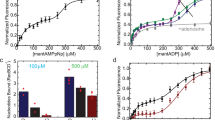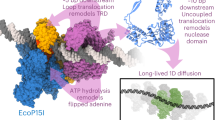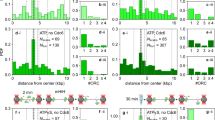Abstract
RecBCD enzyme is a processive DNA helicase1 and nuclease2 that participates in the repair of chromosomal DNA through homologous recombination3,4. We have visualized directly the movement of individual RecBCD enzymes on single molecules of double-stranded DNA (dsDNA). Detection involves the optical trapping of solitary, fluorescently tagged dsDNA molecules that are attached to polystyrene beads, and their visualization by fluorescence microscopy5,6. Both helicase translocation and DNA unwinding are monitored by the displacement of fluorescent dye from the DNA by the enzyme7. Here we show that unwinding is both continuous and processive, occurring at a maximum rate of 972 ± 172 base pairs per second (0.30 µm s-1), with as many as 42,300 base pairs of dsDNA unwound by a single RecBCD enzyme molecule. The mean behaviour of the individual RecBCD enzyme molecules corresponds to that observed in bulk solution.
This is a preview of subscription content, access via your institution
Access options
Subscribe to this journal
Receive 51 print issues and online access
$199.00 per year
only $3.90 per issue
Buy this article
- Purchase on Springer Link
- Instant access to full article PDF
Prices may be subject to local taxes which are calculated during checkout



Similar content being viewed by others
References
Roman, L. J., Eggleston, A. K. & Kowalczykowski, S. C. Processivity of the DNA helicase activity of Escherichia coli recBCD enzyme. J. Biol. Chem. 267, 4207–4214 (1992).
Arnold, D. A. & Kowalczykowski, S. C. in Encyclopedia of Life Sciences [online] (Nature Publishing Group, London, 1999) 〈http:///www.els.net〉.
Kowalczykowski, S. C., Dixon, D. A., Eggleston, A. K., Lauder, S. D. & Rehrauer, W. M. Biochemistry of homologous recombination in Escherichia coli. Microbiol. Rev. 58, 401–465 (1994).
Kuzminov, A. Recombinational repair of DNA damage in Escherichia coli and bacteriophage lambda. Microbiol. Mol. Biol. Rev. 63, 751 –813 (1999).
Perkins, T. T., Smith, D. E. & Chu, S. Direct observation of tube-like motion of a single polymer chain. Science 264, 819– 822 (1994).
Brewer, L. R., Corzett, M. & Balhorn, R. Protamine-induced condensation and decondensation of the same DNA molecule. Science 286, 120– 123 (1999).
Eggleston, A. K., Rahim, N. A. & Kowalczykowski, S. C. A helicase assay based on the displacement of fluorescent, nucleic acid-binding ligands. Nucleic Acids Res. 24 , 1179–1186 (1996).
Ganesan, S. & Smith, G. R. Strand-specific binding to duplex DNA ends by the subunits of Escherichia coli recBCD enzyme. J. Mol. Biol. 229, 67–78 (1993).
Bennink, M. L. et al. Single-molecule manipulation of double-stranded DNA using optical tweezers: interaction studies of DNA with RecA and YOYO-1. Cytometry 36, 200–208 ( 1999).
Taylor, A. F. & Smith, G. R. Substrate specificity of the DNA unwinding activity of the RecBC enzyme of Escherichia coli. J. Mol. Biol. 185, 431–443 (1985).
Roman, L. J. & Kowalczykowski, S. C. Characterization of the helicase activity of the Escherichia coli RecBCD enzyme using a novel helicase assay. Biochemistry 28, 2863– 2873 (1989).
Eggleston, A. K. & Kowalczykowski, S. C. The mutant recBCD enzyme, recB2109CD enzyme, has helicase activity but does not promote efficient joint molecule formation in vitro. J. Mol. Biol. 231, 621–633 (1993).
Taylor, A. & Smith, G. R. Unwinding and rewinding of DNA by the recBC enzyme. Cell 22, 447– 457 (1980).
Xue, Q. F. & Yeung, E. S. Differences in the chemical reactivity of individual molecules of an enzyme. Nature 373, 681–683 (1995).
Wuite, G. J. L., Smith, S. B., Young, M., Keller, D. & Bustamante, C. Single-molecule studies of the effect of template tension on T7 DNA polymerase activity. Nature 404, 103–106 (2000).
Roman, L. J. & Kowalczykowski, S. C. Characterization of the adenosinetriphosphatase activity of the Escherichia coli RecBCD enzyme: Relationship of ATP hydrolysis to the unwinding of duplex DNA. Biochemistry 28, 2873–2881 (1989).
Bianco, P. R. & Kowalczykowski, S. C. Step size measurements on the translocation mechanism of the RecBC DNA helicase. Nature 405, 368–372 ( 2000).
Zaitsev, E. N. & Kowalczykowski, S. C. Binding of double-stranded DNA by Escherichia coli RecA protein monitored by a fluorescent dye displacement assay. Nucleic Acids Res. 26, 650–654 (1998).
Anderson, D. G. & Kowalczykowski, S. C. SSB protein controls RecBCD enzyme nuclease activity during unwinding: a new role for looped intermediates. J. Mol. Biol. 282, 275–285 (1998).
Acknowledgements
We would like to thank S. Chan and J. Lengyel for assistance with measurements, and the following people for their comments on the manuscript: N. Handa, J. Kleiman, A. Mazin, J. New, E. Seitz, M. Spies, T. Sugiyama and Y. Wu. This work was supported by an NIH Grant to S.C.K. and a DOE Center of Excellence for Laser Applications in Medicine Grant to Y.Y. and R.J.B.
Author information
Authors and Affiliations
Corresponding author
Supplementary information
41586_2001_BF35053131_MOESM1_ESM.mov
This movie shows unwinding of a single molecule of lambda DNA by a simgle RecBCD enzyme at 37°C in the presence of 1mM ATP. (MOV 3468 kb)
41586_2001_BF35053131_MOESM2_ESM.mov
This movie shows unwinding of a single molecule of lambda DNA by a simgle RecBCD enzyme at 23°C in the presence of 1mM ATP. (MOV 3622 kb)
41586_2001_BF35053131_MOESM3_ESM.mov
This movie shows unwinding of a single molecule of lambda DNA by a simgle RecBCD enzyme at 23°C in the presence of 250μM ATP. (MOV 3588 kb)
41586_2001_BF35053131_MOESM5_ESM.jpg
A graph showing the amount of active protein in the RecBCD enzyme prepatation used in the experiments described. (JPG 99 kb)
Rights and permissions
About this article
Cite this article
Bianco, P., Brewer, L., Corzett, M. et al. Processive translocation and DNA unwinding by individual RecBCD enzyme molecules. Nature 409, 374–378 (2001). https://doi.org/10.1038/35053131
Received:
Accepted:
Issue Date:
DOI: https://doi.org/10.1038/35053131
This article is cited by
-
Auxiliary ATP binding sites support DNA unwinding by RecBCD
Nature Communications (2022)
-
Optical tweezers in single-molecule biophysics
Nature Reviews Methods Primers (2021)
-
Rotation tracking of genome-processing enzymes using DNA origami rotors
Nature (2019)
-
A change of view: homologous recombination at single-molecule resolution
Nature Reviews Genetics (2018)
-
Nucleotide-dependent DNA gripping and an end-clamp mechanism regulate the bacteriophage T4 viral packaging motor
Nature Communications (2018)
Comments
By submitting a comment you agree to abide by our Terms and Community Guidelines. If you find something abusive or that does not comply with our terms or guidelines please flag it as inappropriate.



